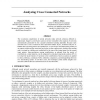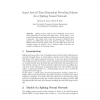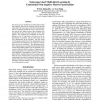AAAI
2012
12 years 6 months ago
2012
In many real applications, especially those involving data objects with complicated semantics, it is generally desirable to discover the relation between patterns in the input spa...
JCNS
2010
13 years 11 months ago
2010
The early processing of sensory information by neuronal circuits often includes a reshaping of activity patterns that may facilitate the further processing of stimulus representat...
TNN
1998
14 years 3 months ago
1998
—Adaptive resonance theory (ART) describes a family of self-organizing neural networks, capable of clustering arbitrary sequences of input patterns into stable recognition codes....
NECO
2008
14 years 4 months ago
2008
The perceptron (also referred to as McCulloch-Pitts neuron, or linear threshold gate) is commonly used as a simplified model for the discrimination and learning capability of a bi...
SPIESR
1993
14 years 5 months ago
1993
Autosophy, an emerging new science, explains "Self-assembling Structures", such crystals or living trees, in mathematical terms. This research provides a new mathematica...
NIPS
1993
14 years 5 months ago
1993
The non-linear complexities of neural networks make network solutions difficult to understand. Sanger's contribution analysis is here extended to the analysis of networks aut...
ESANN
2004
14 years 5 months ago
2004
Spiking neurons model a type of biological neural system where information is encoded with spike times. In this paper, a new method for decoding input spikes according to their abs...
AAAI
2006
14 years 5 months ago
2006
We present a novel framework for multi-label learning that explicitly addresses the challenge arising from the large number of classes and a small size of training data. The key a...
ICCAD
1992
IEEE
14 years 8 months ago
1992
IEEE
Excessive power dissipation in integrated circuits causes overheating and can lead to soft errors and or permanent damage. The severity of the problem increases in proportion to t...
IWANN
1999
Springer
14 years 8 months ago
1999
Springer
Recently, a real-time clustering microchip based on the ART1 algorithm has been reported. That chip was able to classify 100-bit input patterns into up to 18 categories. However, i...



